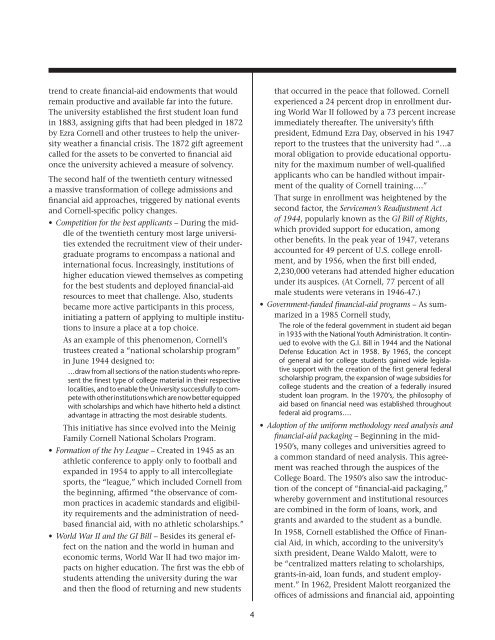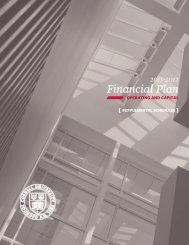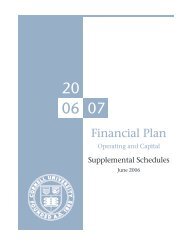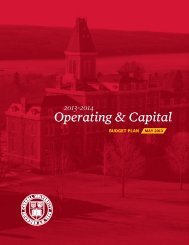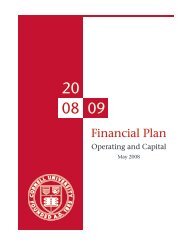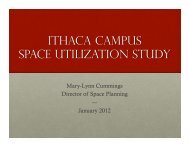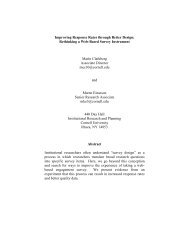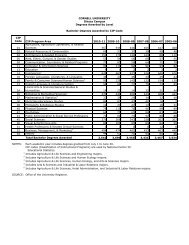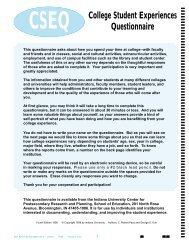Undergraduate Student Access - Cornell University Division of ...
Undergraduate Student Access - Cornell University Division of ...
Undergraduate Student Access - Cornell University Division of ...
You also want an ePaper? Increase the reach of your titles
YUMPU automatically turns print PDFs into web optimized ePapers that Google loves.
trend to create financial-aid endowments that wouldremain productive and available far into the future.The university established the first student loan fundin 1883, assigning gifts that had been pledged in 1872by Ezra <strong>Cornell</strong> and other trustees to help the universityweather a financial crisis. The 1872 gift agreementcalled for the assets to be converted to financial aidonce the university achieved a measure <strong>of</strong> solvency.The second half <strong>of</strong> the twentieth century witnesseda massive transformation <strong>of</strong> college admissions andfinancial aid approaches, triggered by national eventsand <strong>Cornell</strong>-specific policy changes.• Competition for the best applicants – During the middle<strong>of</strong> the twentieth century most large universitiesextended the recruitment view <strong>of</strong> their undergraduateprograms to encompass a national andinternational focus. Increasingly, institutions <strong>of</strong>higher education viewed themselves as competingfor the best students and deployed financial-aidresources to meet that challenge. Also, studentsbecame more active participants in this process,initiating a pattern <strong>of</strong> applying to multiple institutionsto insure a place at a top choice.As an example <strong>of</strong> this phenomenon, <strong>Cornell</strong>’strustees created a “national scholarship program”in June 1944 designed to:…draw from all sections <strong>of</strong> the nation students who representthe finest type <strong>of</strong> college material in their respectivelocalities, and to enable the <strong>University</strong> successfully to competewith other institutions which are now better equippedwith scholarships and which have hitherto held a distinctadvantage in attracting the most desirable students.This initiative has since evolved into the MeinigFamily <strong>Cornell</strong> National Scholars Program.• Formation <strong>of</strong> the Ivy League – Created in 1945 as anathletic conference to apply only to football andexpanded in 1954 to apply to all intercollegiatesports, the “league,” which included <strong>Cornell</strong> fromthe beginning, affirmed “the observance <strong>of</strong> commonpractices in academic standards and eligibilityrequirements and the administration <strong>of</strong> needbasedfinancial aid, with no athletic scholarships.”• World War II and the GI Bill – Besides its general effecton the nation and the world in human andeconomic terms, World War II had two major impactson higher education. The first was the ebb <strong>of</strong>students attending the university during the warand then the flood <strong>of</strong> returning and new studentsthat occurred in the peace that followed. <strong>Cornell</strong>experienced a 24 percent drop in enrollment duringWorld War II followed by a 73 percent increaseimmediately thereafter. The university’s fifthpresident, Edmund Ezra Day, observed in his 1947report to the trustees that the university had “…amoral obligation to provide educational opportunityfor the maximum number <strong>of</strong> well-qualifiedapplicants who can be handled without impairment<strong>of</strong> the quality <strong>of</strong> <strong>Cornell</strong> training….”That surge in enrollment was heightened by thesecond factor, the Servicemen’s Readjustment Act<strong>of</strong> 1944, popularly known as the GI Bill <strong>of</strong> Rights,which provided support for education, amongother benefits. In the peak year <strong>of</strong> 1947, veteransaccounted for 49 percent <strong>of</strong> U.S. college enrollment,and by 1956, when the first bill ended,2,230,000 veterans had attended higher educationunder its auspices. (At <strong>Cornell</strong>, 77 percent <strong>of</strong> allmale students were veterans in 1946-47.)• Government-funded financial-aid programs – As summarizedin a 1985 <strong>Cornell</strong> study,The role <strong>of</strong> the federal government in student aid beganin 1935 with the National Youth Administration. It continuedto evolve with the G.I. Bill in 1944 and the NationalDefense Education Act in 1958. By 1965, the concept<strong>of</strong> general aid for college students gained wide legislativesupport with the creation <strong>of</strong> the first general federalscholarship program, the expansion <strong>of</strong> wage subsidies forcollege students and the creation <strong>of</strong> a federally insuredstudent loan program. In the 1970’s, the philosophy <strong>of</strong>aid based on financial need was established throughoutfederal aid programs….• Adoption <strong>of</strong> the uniform methodology need analysis andfinancial-aid packaging – Beginning in the mid-1950’s, many colleges and universities agreed toa common standard <strong>of</strong> need analysis. This agreementwas reached through the auspices <strong>of</strong> theCollege Board. The 1950’s also saw the introduction<strong>of</strong> the concept <strong>of</strong> “financial-aid packaging,”whereby government and institutional resourcesare combined in the form <strong>of</strong> loans, work, andgrants and awarded to the student as a bundle.In 1958, <strong>Cornell</strong> established the Office <strong>of</strong> FinancialAid, in which, according to the university’ssixth president, Deane Waldo Malott, were tobe “centralized matters relating to scholarships,grants-in-aid, loan funds, and student employment.”In 1962, President Malott reorganized the<strong>of</strong>fices <strong>of</strong> admissions and financial aid, appointing4


